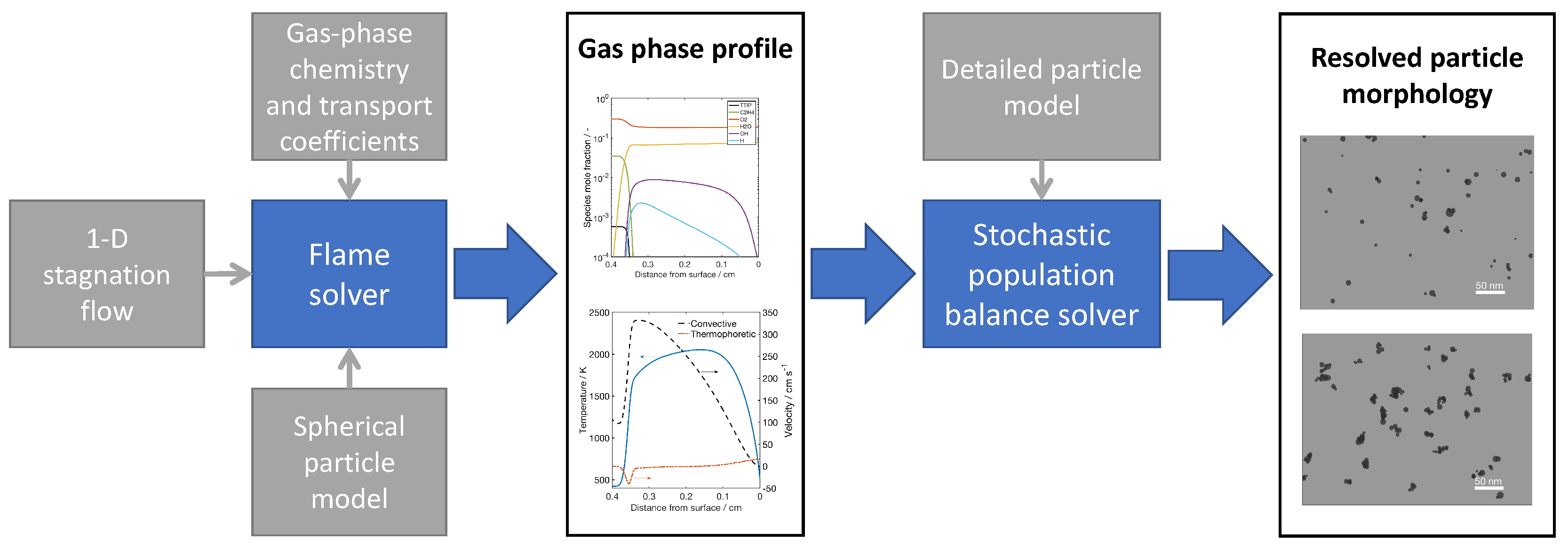Technical Report 204, c4e-Preprint Series, Cambridge
A two-step simulation methodology for modelling stagnation flame synthesised aggregate nanoparticles
Reference: Technical Report 204, c4e-Preprint Series, Cambridge, 2018
- A two-step simulation methodology is presented for resolving the detailed morphology of stagnation flame synthesised nanoparticles.
- The methodology facilitates simulation of quantities directly comparable to experimental observations e.g. TEM images.
- A correction is introduced to the post-process to account for thermophoretic transport effects arising due to a steep temperature gradient.
 A two-step simulation methodology for modelling the stagnation flame synthesis of aggregate nanoparticles is presented. In the first step, a detailed chemical mechanism is coupled with a one-dimensional stagnation flow model and spherical particle model solved by method of moments with interpolative closure. The resulting gas-phase profile is post-processed with a detailed stochastic population balance model to simulate the evolution of the population of particles, including the evolution of each individual primary particle and their connectivity with other primaries in an aggregate. The particles evolve through surface growth, coagulation and sintering. A thermophoretic correction is introduced to the post-processing step as a simulation volume scaling term to account for thermophoretic transport effects arising due to the steep temperature gradient near the stagnation surface. The methodology is evaluated by applying it to the combustion synthesis of titanium dioxide from titanium tetraisopropoxide (TTIP) precursor. The feasibility of the methodology is demonstrated for simulating the complex aggregate morphology of stagnation flame synthesised nanoparticles and modelling quantities that are directly comparable to experimental observations.
A two-step simulation methodology for modelling the stagnation flame synthesis of aggregate nanoparticles is presented. In the first step, a detailed chemical mechanism is coupled with a one-dimensional stagnation flow model and spherical particle model solved by method of moments with interpolative closure. The resulting gas-phase profile is post-processed with a detailed stochastic population balance model to simulate the evolution of the population of particles, including the evolution of each individual primary particle and their connectivity with other primaries in an aggregate. The particles evolve through surface growth, coagulation and sintering. A thermophoretic correction is introduced to the post-processing step as a simulation volume scaling term to account for thermophoretic transport effects arising due to the steep temperature gradient near the stagnation surface. The methodology is evaluated by applying it to the combustion synthesis of titanium dioxide from titanium tetraisopropoxide (TTIP) precursor. The feasibility of the methodology is demonstrated for simulating the complex aggregate morphology of stagnation flame synthesised nanoparticles and modelling quantities that are directly comparable to experimental observations.
Material from this preprint has been published in Combustion and Flame.
PDF (4.6 MB)



